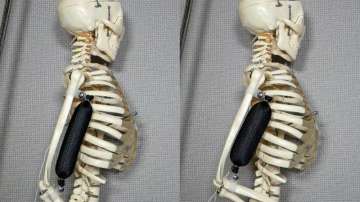With synthetic muscle that can lift 1,000 times its own weight, Terminator-like robots closer to reality
The idea of lifelike robots has moved a step closer to reality with scientists developing a new type of synthetic soft muscle capable of lifting 1,000 times its own weight

The idea of lifelike robots has moved a step closer to reality with scientists developing a new type of synthetic soft muscle capable of lifting 1,000 times its own weight.
The rubber-like synthetic muscle that expands and contracts very much like its biological counterpart have been manufactured using a 3D printing technique. Heated by a small electric current, the material was capable of expanding up to nine times its normal size.
The synthetic soft muscle doesn’t need an external compressor or high-voltage equipment like the previous models, and can push, pull, bend and twist, as well as lift weight.
The material used has a strain density that is 15 times larger than natural muscle.

"We have been making great strides towards making robot minds, but robot bodies are still primitive," said Hod Lipson, professor at Columbia University in the US.
"This is a big piece of the puzzle and, like biology, the new actuator can be shaped and reshaped a thousand ways. We have overcome one of the final barriers to making lifelike robots," Lipson added.
Researchers, in order to achieve an actuator with high strain and high stress coupled with low density, used a silicone rubber matrix with ethanol distributed throughout in micro-bubbles.
The solution combined the elastic properties and extreme volume change attributes of other material systems while also being easy to fabricate, low cost, and made of environmentally safe materials, they said.
After being 3D-printed into the desired shape, the artificial muscle was electrically actuated using a thin resistive wire and low-power. It was tested in a variety of robotic applications where it showed significant expansion-contraction ability.
Being capable of expansion up to 900 per cent when electrically heated to 80 degree Celsius via computer controls, the autonomous unit is capable of performing motion tasks in almost any design, researchers said.
"Our soft functional material may serve as robust soft muscle, possibly revolutionising the way that soft robotic solutions are engineered today. It can push, pull, bend, twist, and lift weight," said Aslan Miriyev, a postdoctoral researcher a Columbia University.
"It is the closest artificial material equivalent we have to a natural muscle," Miriyev said. Previously no material has been capable of functioning as a soft muscle due to an inability to exhibit the desired properties of high actuation stress and high strain.
The study was published in the journal Nature Communications.
